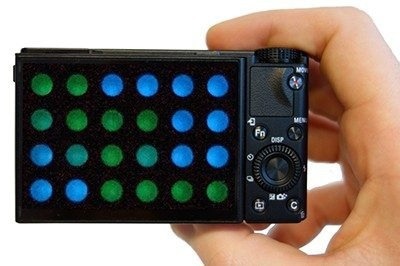Despite significant advances, numerous highly sensitive viral disease diagnostic tests even now require complex techniques to prepare a sample or decipher a result, making them inconvenient for point-of-care settings or areas with limited resources. However, researchers reporting in ACS Central Science have established a sensitive method for analyzing viral nucleic acids that can be completed in one step using “glow-in-the-dark” proteins.
 Proteins that glow bright blue or green, as pictured here, could make disease diagnosis quicker and easier. Image Credit: Maarten Merkx.
Proteins that glow bright blue or green, as pictured here, could make disease diagnosis quicker and easier. Image Credit: Maarten Merkx.
The flash of a firefly, the glowing lure of an anglerfish, and the ghostly blue of phytoplankton-covered beaches are all fueled by the very same scientific phenomenon called bioluminescence. The luminescent, glow-in-the-dark effect is caused by a chemical reaction involving the luciferase protein.
The luciferase protein has been integrated into sensors that, when they locate their target, emit light. This ease of use makes these sensors ideal for point-of-care testing, but they lack the incredibly high sensitivity needed for clinical diagnostic tests. CRISPR gene editing might provide this capability, but it necessitates many steps and specialized equipment to identify what can be a low signal in a complex, noisy sample.
As a result, Maarten Merkx and co-workers wanted to use CRISPR-related proteins but integrate them with a bioluminescence technique whose signal could be identified using only a digital camera.
The researchers used recombinase polymerase amplification (RPA), a simple method that functions at a constant temperature of about 100 ºF, to ensure there was enough sample RNA or DNA to analyze.
The new LUNAS (luminescent nucleic acid sensor) technique attaches a distinct fragment of luciferase to two CRISPR/Cas9 proteins specific for different neighboring parts of a viral genome. If the researchers found a specific viral genome, the two CRISPR/Cas9 proteins would attach to the targeted nucleic acid sequences and come close to each other, enabling the entire luciferase protein to form and shine blue light in the presence of a chemical substrate.
To account for the depletion of this substrate, the scientists used a green control reaction. A positive result was indicated by a tube that changed from green to blue.
RPA-LUNAS successfully identified SARS-CoV-2 RNA in clinical samples taken from nasal swabs within 20 minutes, even at concentrations as low as 200 copies per μl. According to the investigators, the LUNAS assay has great potential for identifying several other viruses effectively and easily.
Source:
Journal reference:
van der Veer, H. J., et al. (2023) Glow-in-the-Dark Infectious Disease Diagnostics Using CRISPR-Cas9-Based Split Luciferase Complementation. ACS Central Science. doi.org/10.1021/acscentsci.2c01467.